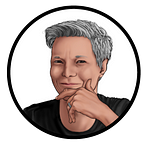Stickers & Wheels
I didn’t post my musings last week because I was caught up in the excitement of the Nooks launch. (What, Mary? I missed that. Tell me more! Check it out here.)
This week, I’ve been musing about stickers & wheels. It started when my son, Maxwell Donahue, designed some cool new stickers:
And then I had a catchup call with Julie Trell who told me about this Wheel of Power/Privilege (which she wrote about it in this great post):
I appreciate the spectrum of categories in this wheel. It helps me see aspects of my identity which make me more marginalized and those which bring me closer to power. Looking at it like this, I know where I can use my power to make structural changes and where I need to ask those with more power to advocate for changes.
Inclusive Design
I identify as “temporarily able-bodied.” In my experience, most people without disabilities don’t think about their ability power/privilege — until they do. In my 20s, I wouldn’t even notice if there was a step up to a restaurant. Then, in my 30s, I started dining out with my son, who uses a power wheelchair (in case you don’t know, those chairs are HEAVY), and I noticed every step, everywhere.
As part of my parenting journey, I learned about Inclusive Design, often referred to as “the curb-cut effect.” Inclusive Design is the concept that “designing for people with permanent disabilities actually results in designs that benefit people universally.” By solving for one, we benefit many — a curb-cut for a sidewalk is designed for wheelchair users but also benefits people pushing strollers or riding bikes.
Hmmm…what if we apply inclusive design to making tech communities inclusive? We’d focus on making online & in-person community spaces inclusive for the most marginalized community members, and that would make them inclusive for all. Amazing!
Change is hard
It all seems so simple — I mean, why NOT design for everyone, in physical spaces or tech communities? Well, it takes extra time, which is hard (just like being anti-racist is hard). But, an even bigger hurdle is that it changes things we (the “we” who are not disabled) have taken for granted. Yup, I’m guilty of being jarred by a light switch being lower on the wall than my muscle memory expects it to be. (Note that even though I might miss the switch the first time, I can still turn on the light.)
I believe that folks with more power/privilege are just as capable of adapting as marginalized folks, they just need more experience getting used to it. Being “adaptable” is a core skill set for a disabled person, who is continually adapting to a world NOT designed for them. I see a future where everyone learns the skill of adapting and spaces become more inclusive, by design.
Knowing what to change
I’m not disabled, so how will I figure out what to do to be inclusive? Luckily, there’s a sticker (and many websites, see Resources below) for that:
“Nothing about us without us.” Don’t guess. Ask!
Do you know anyone who’s disabled? You probably do…26% of adults in the US are disabled, but some disabilities are invisible. Are you following anyone on social media who posts about #DisabilityRights? Or, do you need to Diversify Your Feed (shameless plug for a past blog post of mine!)?
I didn’t know anyone with dwarfism until I met TEDx speaker Becky Kekula, Director, Disability Equality Index, at Disability:IN. We met when she spoke at a large tech conference in 2019. A conference I’d spent 7 years making more inclusive — increasing representation on stage, introducing pronoun buttons & gender-neutral bathrooms, adding a ramp for the stage, etc. — but I missed one simple, inexpensive change that would have made the event more inclusive for Becky: a step-stool in the restroom. I missed it because I didn’t know about it — until I asked Becky.
I’ve learned that the best way to make a space inclusive is to have representation across all of the Power/Privilege Wheel identities on your organizing team or as advisors (paid advisors, let’s be clear!).
Make the change
I’ve now started asking everyone (even people who are closer to the Power center in the wheel): is there anything we could do to make this product/event/community more inclusive? None of us can possibly know everything, and googling helps, but sometimes we don’t even know what to google.
So, go ahead: add this question to your surveys and conversations, make the changes, and make your community more inclusive. Let me know how it goes, and I’ll send you some glitter stickers!
Resources
- Inclusive Design
- The Transgender Law Center’s Trans Agenda for Liberation: Pillar 1
- Code of Conduct example from TechInclusion
